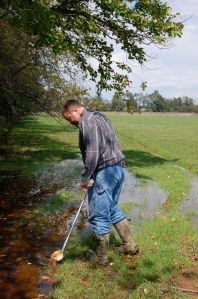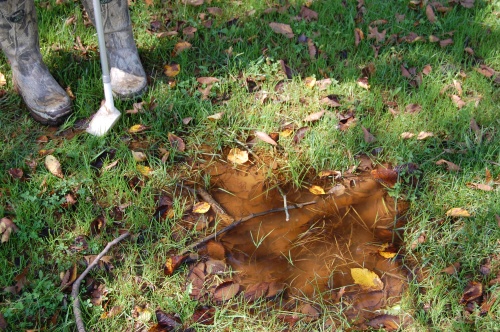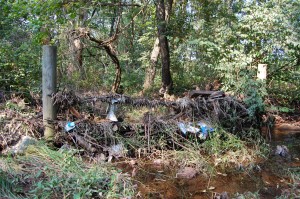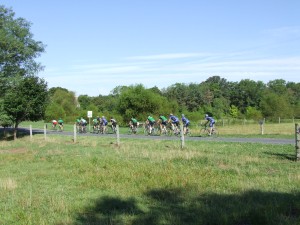Farmers are scientists. And like any other scientists, they’re resourceful.
If they don’t know the answer to something, they know where to find it, or they probably know which neighbor can steer them in the right direction.
Most of the northeast has had more than enough rain for one month. Rain means puddles, puddles mean mosquitoes, and mosquitoes mean nasty diseases that can affect both humans and animals. Irene and her friends left more rain than we’ve seen in years, and we’re still dealing with the remnants.
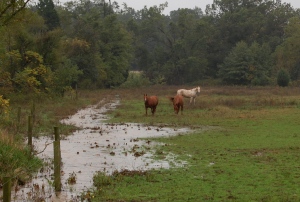
Horses are susceptible to a number of mosquito-borne diseases that are especially bad after excess rain causes ponding.
Remnant: noun. leftover part.
Synonyms: balance, dregs, excess, leavings, leftovers, remainder, residual, residue.
One disease that thrives in residual water is West Nile Virus (WNV), an arbovirus that caused nationwide panic when it was identified in New York in 1999. It was the most exotic-sounding disease to surface in a long time, and was treated as an emerging infectious disease by the CDC. The disease spread, and although the initial panic has subsided, WNV is still present throughout the United States. Wild birds are the primary reservoir for WNV. Most species carry the disease without being affected. However, some birds, including crows, blue jays, magpies and ravens, (Corvidae family if you’re a biology geek) are very susceptible to West Nile Virus. That’s why many states have asked residents to report dead birds of those species.
So after the 15+ inches of rain from Irene and other tropical storms subsided, it became pretty obvious that the puddles in (yes, in) and around the barn weren’t going away any time soon. I decided that it was time to make sure we weren’t hosting a breeding bonanza for mosquitoes.
As a farmer, I know that one of the resources I can rely on is our local conservation
district. I called, and the West Nile Virus technician came out the next day. The first samples he took were from standing water in ruts made by the tractor tires.
He found a few squirming larvae and plunked them into a sample container. But the real bonanza was still waiting. Due to the super-saturated ground and seepage of ground water into one section of our barn, several semi-permanent puddles had formed. I was ready to give them names. The technician scooped out
a little bit of water, barely enough to cover the bottom of his collection cup. The little sea monkey larvae were too numerous to count, and from just a small sample. The tech identified egg rafts and some almost-ready-for-prime-time pupae that would soon hatch, fly around, bite us or our horses and no doubt lay more eggs. And so on.
What we saw in that small sample of water was amazing, but they were all better off dead. Most of us are familiar with the less-than-pleasant biological factoid that only female mosquitoes bite. That’s because those females require a blood meal prior to laying eggs. Once the eggs are laid, they go through several stages and voila! They’re full-fledged adults, ready for a blood meal.
We were amazed at the little creatures; some wigglers (larvae) and some of them tumblers (pupae).
But we weren’t so amazed that we would let them survive. West Nile Virus is a serious threat to humans and can be deadly to horses. The technician treated the puddles with Bs, or Bacillus sphaericus – a naturally occurring bacterium that release toxins into the mosquito’s gut. The toxin disrupts the gut in the mosquito by binding to receptor cells (present in insects but not in mammals) which causes the larvae to stop eating and die.
Next step? Check to see what kind of adult mosquitoes are actively laying eggs. For the barn, this means using a gravid trap, which is designed to attract pregnant female mosquitoes ready to lay eggs.
The device on top draws air through a collection chamber. Female mosquitoes are attracted by the stagnant water and attempts to land on the water surface to lay her eggs. She is drawn into the collection chamber and trapped.
We also decided to set a light trap to collect adults that might be seeking a blood meal.
The light trap, or CO2 trap, is hung from a tree branch and collects mosquitoes overnight. Mosquitoes are attracted to the CO2 that is emitted from the trap, just as they’d be attracted to the CO2 emitted by a human.
We may still be dealing with the remnants of excess rain for weeks to come, although cooler weather will help slow mosquito breeding. Until then, we’re watching and treating every puddle and pool of water that shows signs of life…life that has the potential to make us humans seriously ill.

